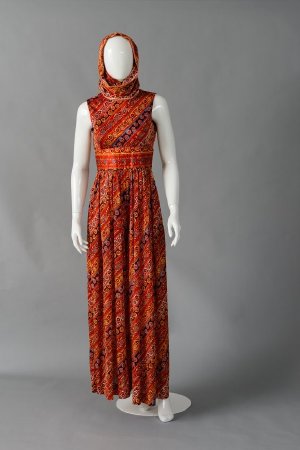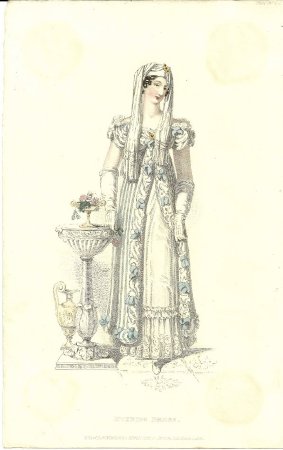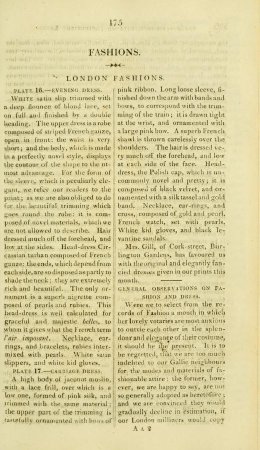Object ID:
2013.4.28
Label/Maker:
Ackermann, Rudolph
Date:
March 1, 1816
Object Details:
The Ackermann illustration dating from March of 1816 depicts a woman serenely posing with Neoclassical props. She wears a floor-length empire-waisted underdress with a ruffle detail at the bottom of the skirt. Over the underdress is a striped empire-waisted evening outer-gown which fans out below the waistline. The striped outer-gown is trimmed with white and blue ruffled ribbon. The bodice is similarly oramented with ruffles and ruching, including a gold and red pendant pinned to the centre of the bodice. Elbow-length gloves cover the arms for warmth and a modest appeal. An interesting component is revealed through the stylized turban which seamlessly connects Western modes of the Regency era in Britain with Eastern fashions promoted by the influence of Lord Byron. A modified turban, embellished by a drape of fabric, creates a beautiful headpiece which frames the wearer. In the centre front of the turban, there is also a gold and red pendant, matching that which sits on the bodice.
Reference:
Cultural Connections:
In 1774, the ban on imported textiles from India was lifted in Britain, thus causing a boom regarding the importation of Indian chintz fabric.5 Although the Ackermann illustration does not show a dress made from chintz, its eclectic style is influenced by the relationship between India and England during the late 18th century. By the early 19th century, not only was chintz fabric a common material in Britain, but Eastern fashions were also interpreted by those who travelled abroad by way of the East India Trading Company. Eastern-influenced styles were fully embraced by 1816, encompassed in the craze for exoticism --- the fascination with styles and elements from far away regions.
Clothing in the 1970s was well known for its use of Bohemian, psychedelic, and Eastern European folk costume. Designer Yves Saint Laurent displayed an interest in the perceived exotic with the launch of his perfume "Opium" in 1977 which was inspired by China and coincided with his Autumn/Winter collection. 6 Just as the Ackermann illustration suggests an enchantment with the East, Narducci's jumpsuit captures a similar allure through its stylistic silhouette. These features translate swiftly into fashion during both eras resulting in the corresponding head-covering styles and the overall effect of each interpretation.
Clothing in the 1970s was well known for its use of Bohemian, psychedelic, and Eastern European folk costume. Designer Yves Saint Laurent displayed an interest in the perceived exotic with the launch of his perfume "Opium" in 1977 which was inspired by China and coincided with his Autumn/Winter collection. 6 Just as the Ackermann illustration suggests an enchantment with the East, Narducci's jumpsuit captures a similar allure through its stylistic silhouette. These features translate swiftly into fashion during both eras resulting in the corresponding head-covering styles and the overall effect of each interpretation.
Reference:
5 Susan North, 18th-Century Fashion in Detail, London: Thames & Hudson, 2016, p.159.
6 "Opium," Musée Yves Saint Laurent Paris, accessed November 25, 2020. https://museeyslparis.com/en/biography/opium.
6 "Opium," Musée Yves Saint Laurent Paris, accessed November 25, 2020. https://museeyslparis.com/en/biography/opium.



